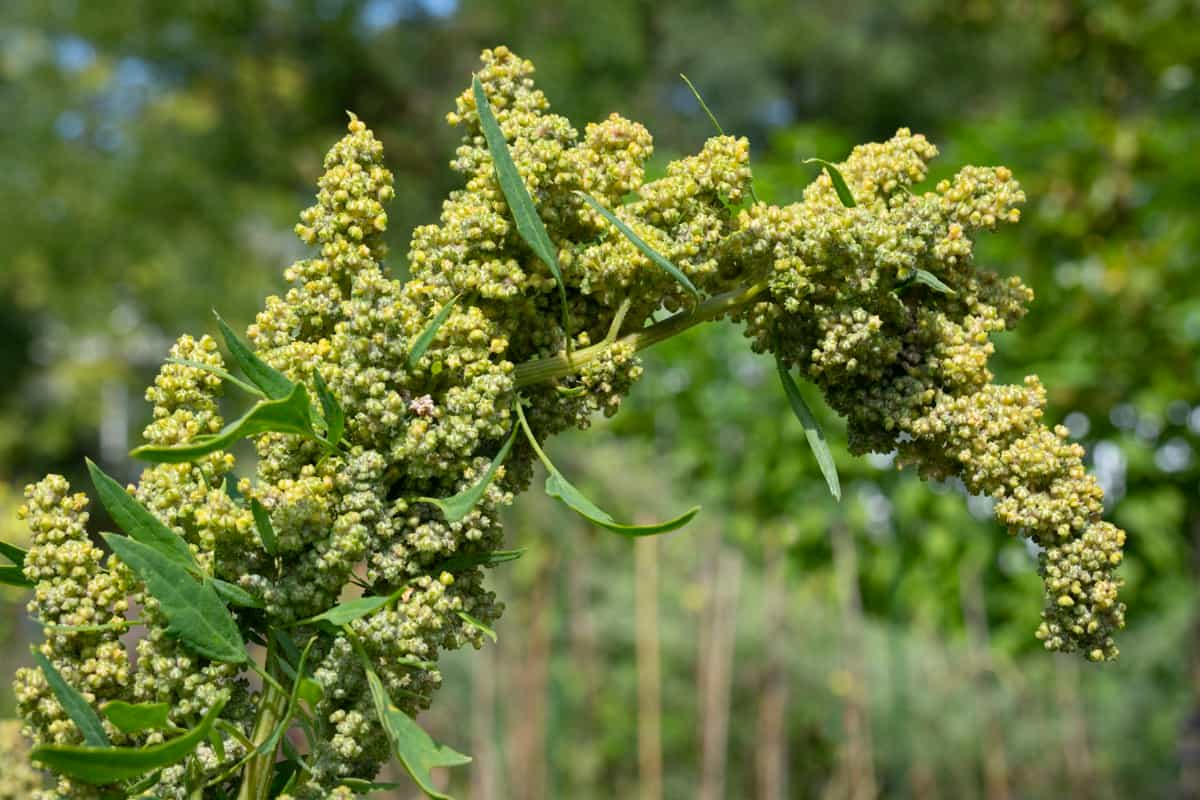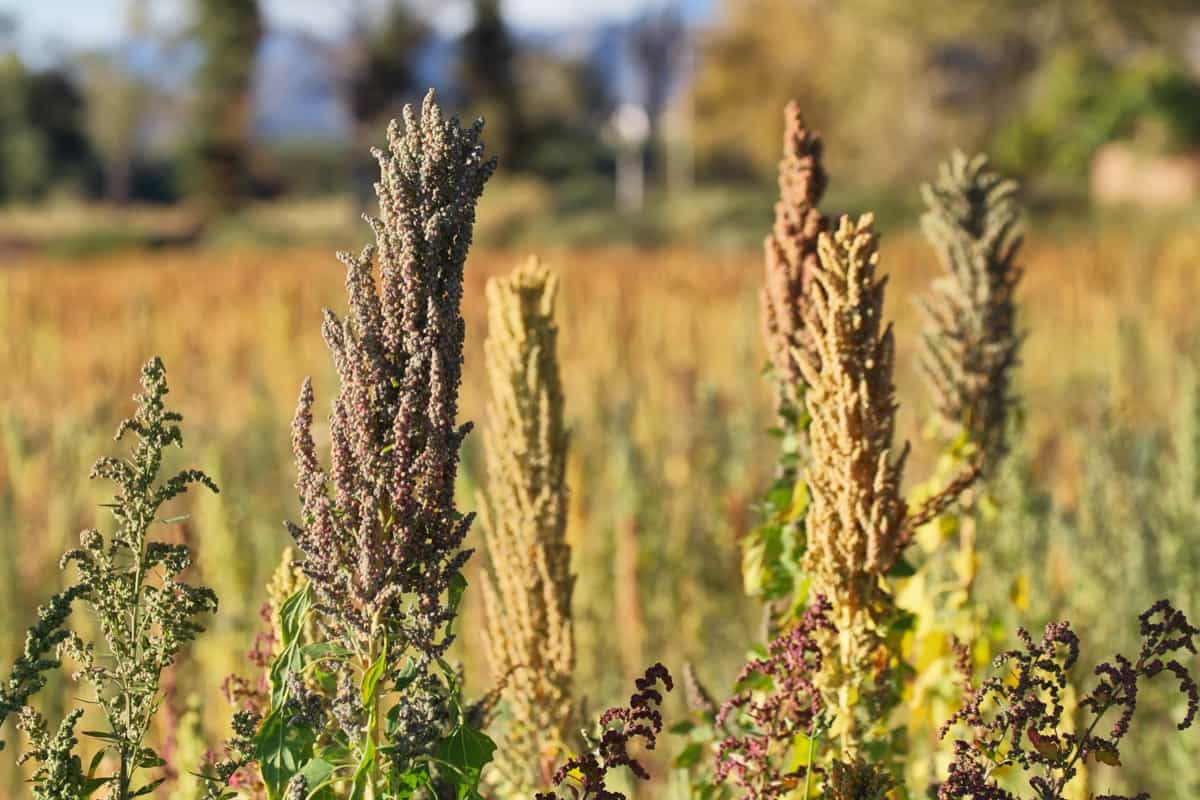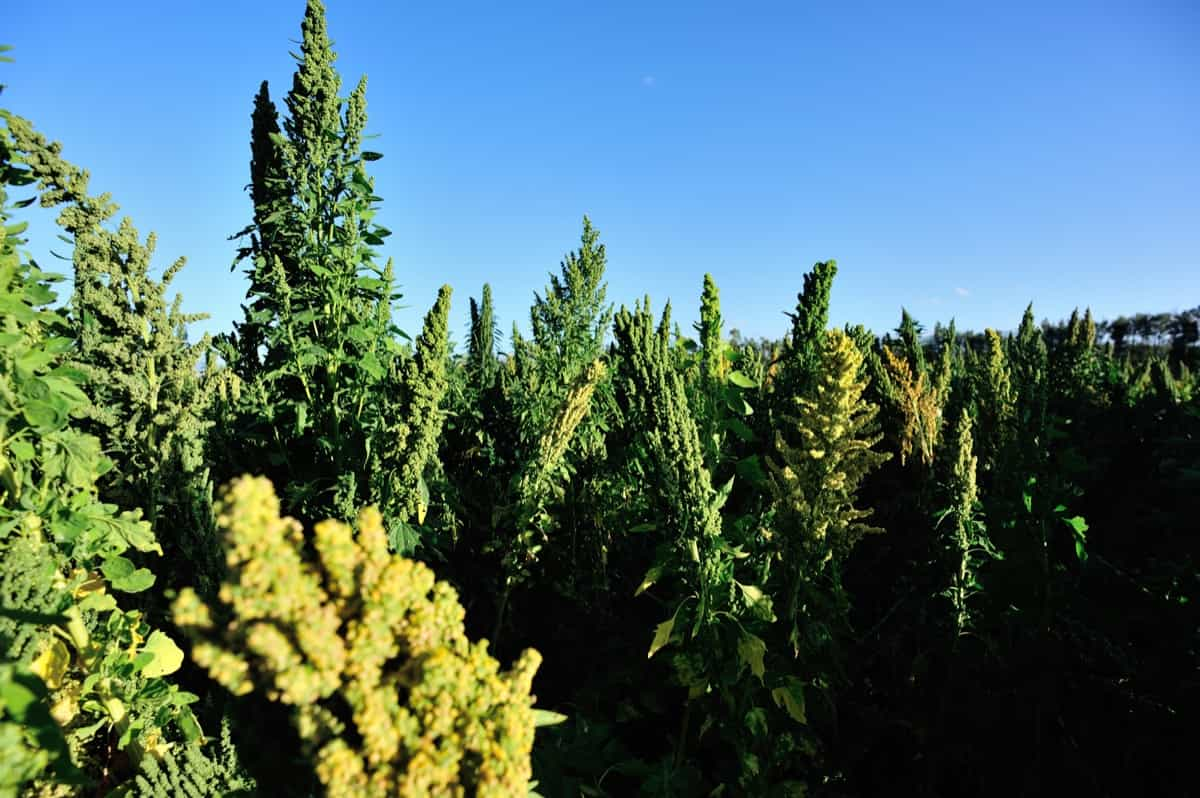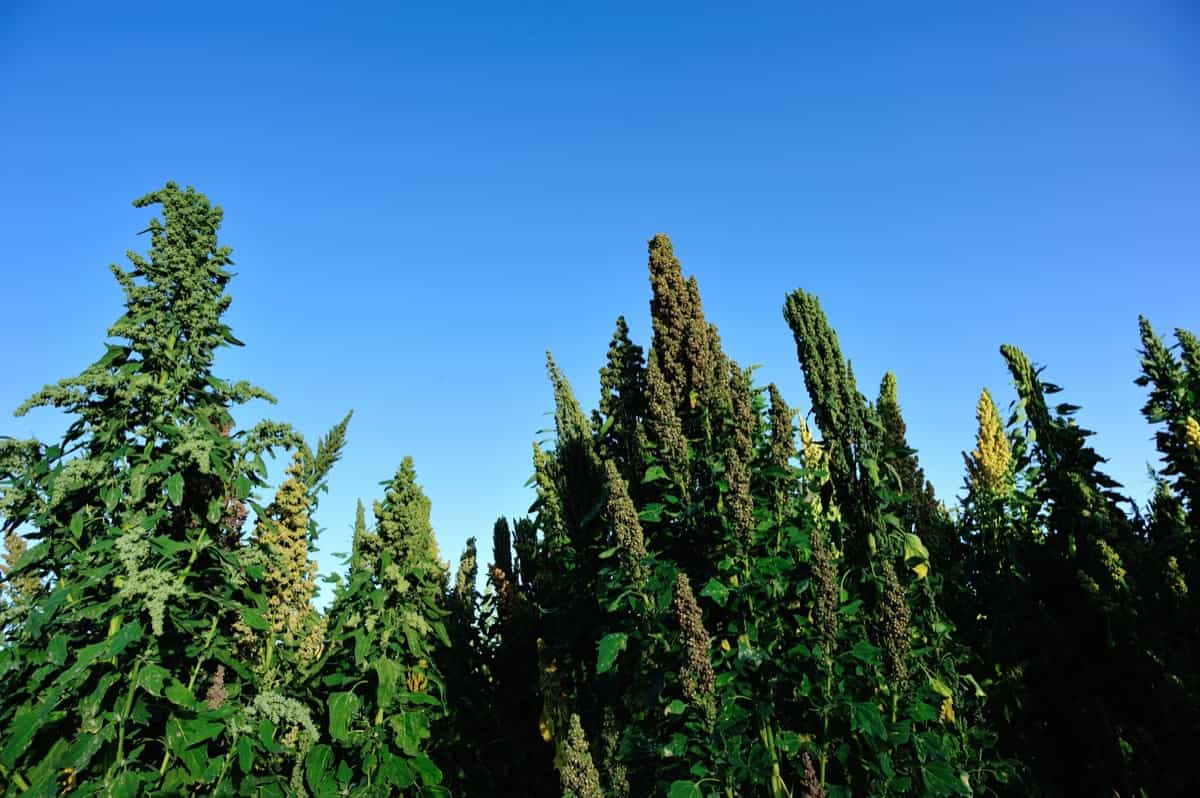Pest management in quinoa is crucial for successful commercial cultivation. Quinoa, a highly nutritious crop, faces its share of insect adversaries. This introductory blog will explore the major insect pests that threaten quinoa crops and discuss effective control and prevention methods. Whether you’re a beginner or an experienced farmer, understanding these essential aspects of pest management will help you safeguard your quinoa harvest. So, let’s dive into the world of quinoa pest control and ensure a thriving quinoa crop for your commercial endeavors.

What is Quinoa Farming?
Quinoa, a member of the Amaranthaceae family, stands out as a climate-resilient crop, uniquely adapted to the challenges posed by climate change. Its exceptional ability to thrive in adverse conditions has become a focal point in expanding cropping systems, especially in regions experiencing rising temperatures, prolonged droughts, poor soil quality, and high salinity.
Quinoa (Chenopodium quinoa Willdenow), a staple food crop in the Andean region of Latin America, thrives in challenging environments and is typically grown at elevations ranging from 2400 to 4000 meters above sea level. This resilient crop boasts exceptional nutritional value, featuring high-quality protein and abundant vitamins and minerals.
According to the National Research Council’s recognition in 1989, its nutritional profile in Latin America and the fight against malnutrition in Latin America and globally. However, the quinoa seed to harvest has challenges, primarily posed by various pests during the cropping season. These threats manifest in miners and borers that consume leaves, stems, roots, and grains and chewing and sucking insects that target foliage.
Need for Pest Management in Quinoa
Climate-Driven Cropping Shift: The impact of climate change on agriculture is pushing us to seek crops better suited to the challenges of rising temperatures, prolonged droughts, poor soil quality, and high salinity. In this context, quinoa, scientifically known as Chenopodium quinoa Willd and belonging to the Amaranthaceae family, has emerged as a promising solution.
Unique Crop Family: Quinoa belongs to an unusual crop family, Amaranthaceae, with only one other member, sugar beets, being cultivated on a large scale in the United States. Most other members of this family are considered weeds, like common lambsquarters.
Remarkable Climate Resilience: Its exceptional resilience to adverse environmental conditions sets quinoa apart. It can produce satisfactory yields with as little as 10-15 inches of irrigation, making it far more water-efficient than wheat, which requires 18-21 inches, and corn, which demands a substantial 25-30 inches of water during the growing season.
Nutritional Powerhouse: Quinoa is not just hardy; it’s also a nutritional powerhouse. Its grains are packed with high-quality proteins containing essential amino acids. This unique trait makes it a complete protein source, something rarely found in plant-based foods. Additionally, quinoa is rich in fiber, vitamins, and minerals, excellent choice for a balanced diet.
Environmental Sustainability: Quinoa’s ability to thrive in low-water and challenging soil conditions contributes to its environmental sustainability. It reduces the strain on water resources and provides an eco-friendly option for crop cultivation.
In case you missed it: Pest Management in Sorghum: Major Insect Pests of Sorghum, Control, and Prevention

Quinoa Growing Essentials for Climate
Growing quinoa presents challenges, especially related to its climate requirements. Originating in mountainous regions, quinoa thrives in cool temperatures and shorter daylight hours, conditions uncommon in many agricultural areas. Excessively high temperatures above 95 degrees F (35 C) can induce dormancy in quinoa plants or make their pollen sterile.
This temperature sensitivity underscores the need for small-scale experimentation before committing to larger quinoa cultivation. On the positive side, quinoa is versatile regarding soil conditions. It can tolerate poor drainage, low soil fertility, high salinity, and a broad pH range from 4.8 to 8.5. Furthermore, quinoa exhibits resilience to frost, withstanding temperatures as low as 28 degrees F (-2.2 C).
However, its slow growth rate post-emergence poses weed management challenges. Studies have shown that no-till preparation methods may produce more visible weeds than tilled fields. Home gardeners can resort to hand-pulling weeds, while commercial growers should consult their local extension office for the latest herbicide recommendations tailored to quinoa.
Quinoa Pests: Challenges and Control Measures
Quinoa, belonging to the same plant family as spinach, chard, and beets, shares its susceptibility to certain invertebrate pests, posing challenges for growers. These pests can significantly reduce yields and the overall vitality of quinoa crops. Several harmful bugs have been identified in quinoa test crops, including various species of flea beetles, aphids, and cutworms.
- Pest Diversity: Quinoa’s botanical relatives attract pests that can also affect quinoa. Among them are flea beetles, aphids, and cutworms, which can damage quinoa plants.
- Limited Pesticide Options: Currently, no pesticides are specifically approved for use on quinoa, making pest control a unique challenge for growers.
- Insecticidal Soaps for Home Gardeners: Home gardeners have successfully used insecticidal soaps as a pest control, offering a potential solution for smaller-scale cultivation.
- Predatory Insects: In some cases, predatory insects can serve as natural control measures against certain quinoa pests, offering a more eco-friendly approach to pest management.
Common Quinoa Pests
- Beet Armyworm: Particularly prevalent in Northern US regions, this pest can destroy quinoa seedlings by consuming their leaves and petioles.
- Bertha Armyworm: Quinoa is a secondary host for these caterpillars, and early larval stages are susceptible to weather conditions.
- Goosefoot Groundling Moth: Producing two generations annually, these caterpillars feed on quinoa foliage and panicles, potentially causing significant crop damage if left unchecked.
- Quinoa Plant Bug: This invasive species, while not well-documented, has been known to reduce yields in test crops.
- Stem-Boring Fly: Larvae of the stem-boring fly tunnel into quinoa stems, leading to reduced yields and even plant death.
- Sugarbeet Root Aphid: These root-dwelling aphids can enter the soil through cracks caused by dry weather, leading to wilted plants with pale leaves. Crop rotation and the elimination of host weeds are recommended for control.
- Tarnished Plant Bug: Multiple generations of this quinoa bug can occur within a single season, with a preference for feeding on the reproductive organs of quinoa, ultimately reducing harvest yields.
Major Pests of Quinoa: A Global Challenge
These pests can significantly impact quinoa cultivation on a global scale. Among the most formidable adversaries are two species of Gelechiidae moths: Eurysacca melanocampta and E. quinoae, which are widespread in the Andean region. These pests constantly threaten quinoa plants throughout their growth cycle, with a particularly destructive impact during grain maturation.
In case you missed it: Management of Greenhouse Pests and Diseases: Management, Control, Prevention, and Treatment

Additionally, a group of cutworms (Noctuidae) is notorious for cutting emerging quinoa plants near the ground, causing substantial damage. Weevils, such as Adioristus species in central Peru and Diabrotica species in southern Peru, have been reported to inflict harm on quinoa crops.
The range of insects that affect quinoa is diverse and includes various families, such as Coleoptera (Chrysomelidae, Curculionidae, Meloidae, Melyridae, Tenebrionidae), Diptera (Agromyzidae), Homoptera (Aphididae, Cicadellidae), Lepidoptera (Gelechiidae, Geometridae, Noctuidae, Pyralidae), and Thysanoptera (Thripidae).
In addition to insect pests, birds pose a substantial threat by foraging and damaging mature quinoa inflorescences, potentially leading to yield losses of up to 60%. Various species, including siskins, eared doves, rufous-collared sparrows, and white-throated sierra finches, feed on quinoa grains late in the season. Rodents can also be a concern, particularly during postharvest stages when grains are dried and stored.
Combatting the Quinoa Stem-Boring Insect Pest
Severe Halt to Quinoa Expansion: The promising expansion of quinoa cultivation faced a sudden setback in 2021 with the discovery of a highly destructive pest, the agromyzid fly, Amauromyza karli Hendel (Diptera: Agromyzidae), in Colorado and neighboring states. This insect has inflicted severe yield losses and even total crop destruction. Disturbingly, its presence has also been confirmed in Idaho and Oregon.
Lack of Management Recommendations: The emergence of A. Karli has posed a significant challenge as there currently needs to be management recommendations. Furthermore, there needs to be more knowledge about this fly’s natural history and behavior.
Addressing Critical Knowledge Gaps: To effectively combat this destructive pest, researchers are actively working to address critical knowledge gaps:
Abundance Patterns: Understanding the abundance patterns of A. karli in the field is crucial for informing planting date adjustments and the timing of biological and chemical control measures.
Weed Hosts: Identifying weeds that can serve as hosts to the fly is essential for developing weed management strategies that can lower the risk and severity of infestations in quinoa crops.
Integrated Pest Management: Researchers evaluate various integrated pest management tactics, including host plant resistance within existing quinoa varieties, biological control methods, and systemic insecticides.
Widespread Knowledge Sharing: One of the primary goals is to ensure that the management recommendations, once developed, are widely disseminated among quinoa producers. Collaboration with the Stewart Lab is a key part of this effort.
Understanding the Threat of Eurysacca Insects to Quinoa Crops
Eurysacca melanocampta and Eurysacca quinoae, two destructive insect species, pose a significant threat to quinoa crops. These pests are approximately 8 mm long with a wingspan of about 16 mm. They can be distinguished by their wing patterns, with E. melanocampta featuring a dark longitudinal band on the wings and two dark spots, while E. quinoae has two dark spots and small dark spots at the wing’s apex.
In case you missed it: Management of Hydroponic Pests and Diseases: Control, Prevention, and Treatment

The life cycle of these insects involves small eggs (0.6 mm long and 0.3 mm wide) that hatch into larvae. The larvae go through five instars, ranging from pale green to yellow, with narrow red-maroon longitudinal bands. Pupae, the final stage, are dark maroon.
- E. melanocampta is distributed across xeromontane habitats, from Argentina and Chile in the south to Colombia in the north. On the other hand, E. quinoae was initially believed to have limited distribution but is widespread in Peru, sometimes emerging as a primary pest.
- Reproductive potential for E. melanocampta adult moths can reach around 300 eggs. The development time from egg to adult ranges from 47 to 88 days, primarily influenced by temperature.
- Host plants for E. melanocampta include quinoa (Chenopodium quinoa) and kaniwa (Ch. pallidicaule Aellen) within the Chenopodiaceae family. These insects may enter diapause in the soil or switch to a broader range of host plants, including wild Senecio species, tarwi (Lupinus mutabilis), beans (Vicia faba), and possibly potatoes (Solanum tuberosum).
The economic impact of these pests on quinoa crops varies but can be substantial, with estimated yield losses ranging from 15% to 50% in dry years in Peru. Studies have shown that the relationship between insect density and damage follows an exponential growth function, with increasing larvae density leading to escalating crop loss. However, various factors, such as plant stress, the length of the infestation, the physiological age of the plants, source-sink areas for pest populations, and environmental factors like temperature and rainfall, affect the actual loss these insects cause.
Pest Management in Quinoa: Control and Prevention Methods
Quinoa cultivation has different pest challenges, including Eurysacca insects and other minor pest groups. To ensure healthy quinoa crops and reduce economic losses, a comprehensive approach to pest management
In case you missed it: Management of Vertical Farming Pests and Diseases: Control, Prevention, and Treatment

Cultural Practices
- Sowing Date: Proper timing of sowing can reduce pest invasions.
- Nutrient Management and Irrigation: Adequate nutrient levels and irrigation practices can enhance plant health, making them less susceptible to pests.
- Crop Rotation: Alternating quinoa cultivation with other crops disrupts pest food chains and reduces infestation.
- Mixed Cropping: Planting quinoa alongside companion crops like beans and corn can deter pests.
- Phytosanitation: Clearing fields and surrounding areas of alternative host plants helps prevent pest build-up.
- Tillage Practices: Effective soil management can disrupt pest habitats.
Biological Control
- Parasitoids: Natural enemies like parasitoid wasps (Encyrtidae, Ichneumonidae, Tachinidae) play a vital role in controlling pests, with parasitism rates reaching up to 60%.
- Predators: Beneficial insects such as ladybugs (Coccinellidae), lacewings (Chrysopidae), and ground beetles (Carabidae) contribute to pest suppression.
Biopesticides
- Granulosis Virus: The granulosis virus has shown promise in controlling Eurysacca insects, achieving up to 50% control.
- Antifeedants: Certain plant extracts, like Minthostachys spp., exhibit antifeedant properties, reducing pest damage.
- Pheromones: Pheromones, although not yet isolated for quinoa pests, have potential for pest management.
Host Plant Resistance
- Quinoa Varieties: Some quinoa cultivars, particularly those with compact, dark-colored inflorescences, exhibit partial resistance to pests.
- Bitter vs. Sweet Quinoa: Preliminary observations suggest that bitter cultivars may be less susceptible to pest attacks.
Chemical and Other Control
- Insecticides: While chemical control is an option, it should be used judiciously and based on economic thresholds to prevent resistance and environmental issues.
- Traditional Practices: Some farmers employ methods like applying ashes to the soil or burning rubber to deter pests.
In case you missed it: How to Identify and Control Celery Pests and Diseases: Management Strategies

Conclusion
Integrated pest management (IPM) that combines cultural practices, biological control, biopesticides, host plant resistance, and, if necessary, chemical control offers a holistic approach to safeguarding quinoa crops from pests. IPM minimizes economic losses, promotes sustainability, and reduces the environmental and health impacts associated with extensive pesticide use.
- Pest Management in Quinoa: Major Insect Pest of Quinoa, Control and Prevention Methods
- Pest Management in Sorghum: Major Insect Pests of Sorghum, Control, and Prevention
- Field Preparation for Watermelon: Requirements for High Yield
- Eggplant Shoot and Fruit Borer Management: Control and Prevention for High-Profit Margins
- Weed Management in Tomato Crop: Common Weeds of Tomato and Herbicides Safe for Tomatoes
- Landscaping Rates Per Square Foot India: Estimation of Yard Work Cost for Small and Large Areas
- Top 12 Best Herbicides in India: Guide to Buy Cheap Weed Killing Herbicides at Best Price
- Top 15 Best Fungicides in India: Guide to Buy Cheap Weed Killing Fungicides at Best Price
- 10 Best Garden Tillers in India For Seed Bed Preparation and Weed Control: Price List Included
- 10 Best Hand-Operated Seeding Machines in India: Price List for Top Seed Planters for Vegetables
- Krishi Vigyan Kendra Schemes (KVKs) and Training in India
- Varieties of Castor in India: Boost the Profit with High-yielding Hybrids of Castor
- Cooperative Societies in the Agricultural Sector in India: Benefits, Role, and Challenges
- 17 Gardening Mistakes to Avoid This Summer: For Vegetables, Flowers, Herbs, and Fruits
- Bahar Treatment in Pomegranate for High Quality and Yields: A Step-by-Step Guide to Implementation
- Mobile Veterinary Units in India: Implementation in States
- Moringa as Feed for Livestock: Moringa Fodder Crop Yield Per Acre
- National Beekeeping and Honey Mission (NBHM): Features, Schemes, and Benefits
- Management of Cutworms in Chilli: Prevention and Control With Organic, Chemical, Cultural Practices
- Best Fertilizer for Tinda: Organic, Natural, Homemade, NPK Ratio, When and How to Apply
- Whitefly Management in Cotton Crop: Symptoms, Control, and Best Insecticides for Cotton
- Best Fertilizer for Terrace Plants: Covering Vegetables, Fruits, Flowers, and Herbs
- 12 Best Compost Bins for Home in India with Price: Cheap for Indoors, Outdoors, and Kitchens
- Grapes Training Systems and Methods: A Comparative Analysis
- Best Fertilizer Jamun Tree: Organic, Natural, Homemade, Npk Ratio, When and How to Apply
- Polyhalite Fertilizers and their Role in Organic Farming
- How to Identify Fake Seeds: Key Differences Between Real and Counterfeit Seeds
- Best Fertilizer for Indian Gooseberry/Amla: Organic, Homemade, NPK Ratio, When and How to Apply
- Best Fertilizer for Bitter Gourd: Organic, Natural, Homemade, NPK Ratio, When and How to Apply
- Bangalore Method of Composting: Preparation Method, Benefits, and Disadvantages
- How to Check PM Kisan Status: Beneficiary Verification With Aadhaar Number and Mobile
- 15 Best Chaff Cutter Machines in India: For Dry, Green Fodder Cutting, and Price List Included
- Bermuda Grass Fertilizer Schedule: When and How to Apply in Winter, Summer, and Spring
- 20 Best Plants to Grow Under Oak Trees: Compatible Plants Under and Around Oaks
- Benefits of DAP Fertilizer: Price, Composition, How and When to Apply
- Profitable Thai Guava Farming in India: Yield, Profit Per Acre, Plant Price, 1 Acre Cost of Cultivation
